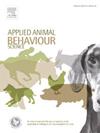Don’t play with your food: Differences in group feeding behaviours of feed efficient and inefficient Chinook salmon (Oncorhynchus tshawytscha)
IF 2.2
2区 农林科学
Q1 AGRICULTURE, DAIRY & ANIMAL SCIENCE
引用次数: 0
Abstract
Production costs in finfish aquaculture can be reduced by improving feed conversion ratio (FCR, the ratio of feed intake to weight gain) but to improve FCR it is important to understand what influences it. As feed intake is one of the two main variables of FCR, analysing feeding behaviours of individuals during meals could explain differences in energy expenditure that influences individual FCR variation in Chinook salmon (Oncorhynchus tshawytscha). The aim of this study was to assess the influence of feeding behaviour on FCR. Feeding behaviours exhibited by feed efficient (FCRE), and inefficient (FCRI) Chinook salmon fed to satiation were characterised using video imaging across three separate meals, each a week apart. To quantify behaviour a scoring criterion was developed based on turning angles, distance travelled, acceptance/rejection of pellets, consumption/spitting of pellets as well as the time taken to make those decisions. Feeding behaviour was found to be consistent within the same group of individuals over a three-week period. FCRI fish exerted more effort during feeding, by carrying out more turns (P < 0.001) and covering more distance (P < 0.001) despite feed intake not differing to that of FCRE fish (P > 0.05). In addition, FCRI fish spat out more pellets rather than ingesting them (P = 0.02), thus further increasing their energy expenditure. These behaviours were recorded in fish fed to satiation as this is consistent with on-farm practices and it is hypothesised that this feeding practice allows for increased energy expenditure in FCRI fish, in particular spitting behaviours, which reduces feed efficiency.
不要玩弄你的食物:饲料效率高和饲料效率低的大腹大鳄群体摄食行为的差异
提高饲料系数(FCR,采食量与增重之比)可以降低鳍鱼养殖的生产成本,但要提高饲料系数,了解影响它的因素很重要。采食量是FCR的两个主要变量之一,分析个体在进餐时的摄食行为可以解释影响奇努克鲑鱼个体FCR变化的能量消耗差异。本研究的目的是评估摄食行为对FCR的影响。研究人员利用视频成像技术,对喂食效率高(fre)和喂食效率低(FCRI)的奇努克鲑鱼的摄食行为进行了表征。为了量化行为,根据转弯角度、行驶距离、接受/拒绝颗粒、消耗/吐出颗粒以及做出这些决定所需的时间,制定了评分标准。在三周的时间内,同一组个体的摄食行为是一致的。尽管采食量与FCRI鱼没有差异(P >; 0.05),但FCRI鱼在摄食过程中付出了更多的努力,通过进行更多的转弯(P <; 0.001)和覆盖更多的距离(P <; 0.001)。此外,FCRI鱼吐出更多的颗粒而不是摄入它们(P = 0.02),从而进一步增加了它们的能量消耗。这些行为被记录在吃饱的鱼身上,因为这与农场的做法是一致的,并且假设这种喂养做法会增加FCRI鱼的能量消耗,特别是吐痰行为,这会降低饲料效率。
本文章由计算机程序翻译,如有差异,请以英文原文为准。
求助全文
约1分钟内获得全文
求助全文
来源期刊

Applied Animal Behaviour Science
农林科学-行为科学
CiteScore
4.40
自引率
21.70%
发文量
191
审稿时长
18.1 weeks
期刊介绍:
This journal publishes relevant information on the behaviour of domesticated and utilized animals.
Topics covered include:
-Behaviour of farm, zoo and laboratory animals in relation to animal management and welfare
-Behaviour of companion animals in relation to behavioural problems, for example, in relation to the training of dogs for different purposes, in relation to behavioural problems
-Studies of the behaviour of wild animals when these studies are relevant from an applied perspective, for example in relation to wildlife management, pest management or nature conservation
-Methodological studies within relevant fields
The principal subjects are farm, companion and laboratory animals, including, of course, poultry. The journal also deals with the following animal subjects:
-Those involved in any farming system, e.g. deer, rabbits and fur-bearing animals
-Those in ANY form of confinement, e.g. zoos, safari parks and other forms of display
-Feral animals, and any animal species which impinge on farming operations, e.g. as causes of loss or damage
-Species used for hunting, recreation etc. may also be considered as acceptable subjects in some instances
-Laboratory animals, if the material relates to their behavioural requirements
 求助内容:
求助内容: 应助结果提醒方式:
应助结果提醒方式:


